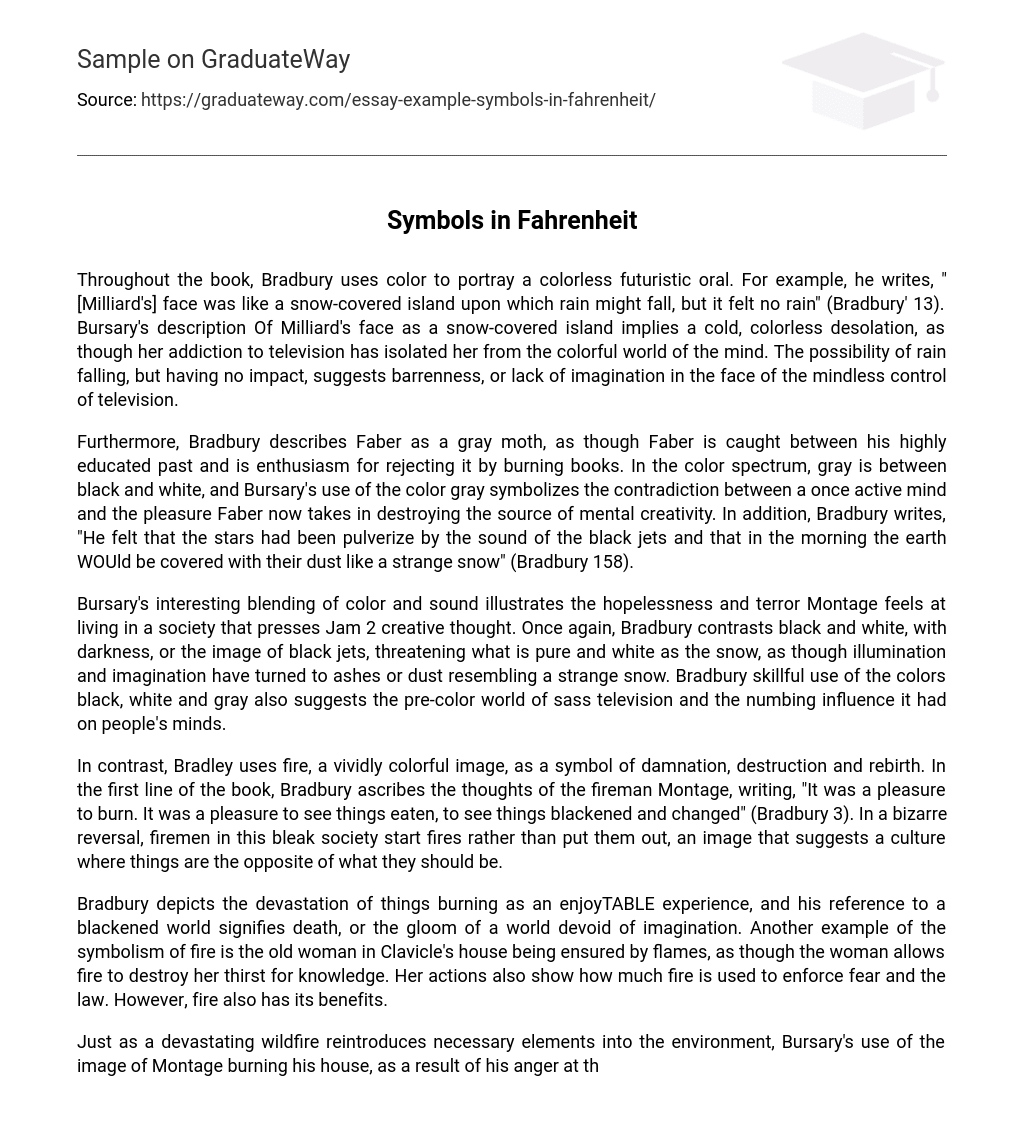Throughout the book, Bradbury uses color to portray a colorless futuristic oral. For example, he writes, “[Milliard’s] face was like a snow-covered island upon which rain might fall, but it felt no rain” (Bradbury’ 13). Bursary’s description Of Milliard’s face as a snow-covered island implies a cold, colorless desolation, as though her addiction to television has isolated her from the colorful world of the mind. The possibility of rain falling, but having no impact, suggests barrenness, or lack of imagination in the face of the mindless control of television.
Furthermore, Bradbury describes Faber as a gray moth, as though Faber is caught between his highly educated past and is enthusiasm for rejecting it by burning books. In the color spectrum, gray is between black and white, and Bursary’s use of the color gray symbolizes the contradiction between a once active mind and the pleasure Faber now takes in destroying the source of mental creativity. In addition, Bradbury writes, “He felt that the stars had been pulverize by the sound of the black jets and that in the morning the earth WOUld be covered with their dust like a strange snow” (Bradbury 158).
Bursary’s interesting blending of color and sound illustrates the hopelessness and terror Montage feels at living in a society that presses Jam 2 creative thought. Once again, Bradbury contrasts black and white, with darkness, or the image of black jets, threatening what is pure and white as the snow, as though illumination and imagination have turned to ashes or dust resembling a strange snow. Bradbury skillful use of the colors black, white and gray also suggests the pre-color world of sass television and the numbing influence it had on people’s minds.
In contrast, Bradley uses fire, a vividly colorful image, as a symbol of damnation, destruction and rebirth. In the first line of the book, Bradbury ascribes the thoughts of the fireman Montage, writing, “It was a pleasure to burn. It was a pleasure to see things eaten, to see things blackened and changed” (Bradbury 3). In a bizarre reversal, firemen in this bleak society start fires rather than put them out, an image that suggests a culture where things are the opposite of what they should be.
Bradbury depicts the devastation of things burning as an enjoyTABLE experience, and his reference to a blackened world signifies death, or the gloom of a world devoid of imagination. Another example of the symbolism of fire is the old woman in Clavicle’s house being ensured by flames, as though the woman allows fire to destroy her thirst for knowledge. Her actions also show how much fire is used to enforce fear and the law. However, fire also has its benefits.
Just as a devastating wildfire reintroduces necessary elements into the environment, Bursary’s use of the image of Montage burning his house, as a result of his anger at the life that has been forced upon him, equates to the Phoenix rising out of the ashes, as though Montage feels compelled to become a new person. Montage realizes that destruction is not the only result of fire, and he makes an analogy to the yes of life, or death and rebirth, implying that fire cannot only destruct, but it can also construct. Moreover, Bradbury use of mirrors symbolizes people’s need to once again think and remember who they are.
Granger brings up the idea of opening a mirror factory, so there will be enough mirrors for people to see their reflections. “Come on now, we’re going to build a mirror factory first and put out nothing but mirrors for the next year and take a long look in them” (Bradbury 164). Bradbury intent is Jam 3 to show that the characters, whose minds have been stifled, do not realize ho they are and have not yet determined their purpose in life. He compares mirrors to personal reflection to show Montage’s need to pull himself out of oblivion in order to see the world from a different perspective.
Additionally, Montage compares Claries to a mirror, as though in her he sees himself, allowing him to remember the richness of the creative human mind. From the beginning of the book, Clavicle’s curiosity leads to Montage’s reflection about what his life has come to. Therefore, in Fahrenheit 451, images such as color, fire, and mirrors symbolize Bradbury disillusionment with a society where mindless castrations and instant gratification are employed to repress man’s instinctive desire for knowledge and individual expression.
Bradbury implies that man must pay the heavy price of death and rebirth to put an end to the struggle to remain human in a world that discourages humanity. So what does Fahrenheit 451 say about 21 SST Century society? Given that most people today always seem to be plugged into some sort of digital device – cell phones, I-pods, video games, the Internet – distracting them from the importance of being human, it is clear that Ray Bradbury was way ahead of his time.





